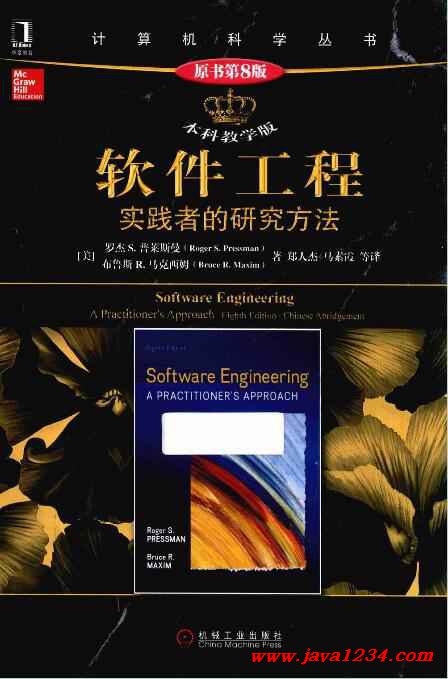| 失效链接处理 |
|
软件工程-实践者的研究方法 第八版 PDF 下载
转载自:http://www.jb51.net/books/593924.html
本站整理下载:
版权归出版社和原作者所有,链接已删除,请购买正版
用户下载说明:
电子版仅供预览,下载后24小时内务必删除,支持正版,喜欢的请购买正版书籍:
http://product.dangdang.com/23655376.html
相关截图:

资料简介:
本书自1982年发行第1版以来,一直受到软件工程界的高度重视,成为高等院校计算机相关专业软件工程课的重要教学参考书。近30年来,它的各个后继版本一直都是软件专业人土熟悉的读物,在国际软件工程界享有无可质疑的权威地位。它在全面而系统、概括而清晰地介绍软件工程的有关概念、原则、方法和工具方面获得了广大读者的好评。此外,本书在给出传统的、对学科发展具有深刻影响的方法时,又适当地介绍了当前正在发展的、具有生命力的新技术。
资料目录:
CHAPTER 1 THE NATURE OF SOFTWARE 1.1 The Nature of Software 1.1.1 Defininq Software 1.1.2 Software Application Domains 1.1.3 Legacy Software 1.2 The Changing Nature of Software 1.2.1 WebApps 1.2.2 Mobile Applications 1.2.3 Cloud Computing 1.2.4 Product Line Software 1.3 Summary PROBIEMS AND POINTS TO PONDER FURTHER READINGS AND INFORMATION SOURCES CHAPTER 2 SOFTWARE ENGINEERING 2.1 Defining the Discipline 2.2 The Software Process 2.2.1 The Process Framework 2.2.2 Umbrella Activities 2.2.3 Process Adaptation 2.3 Software Engineering Practice 2.3.1 The Essence of Practice 2.3.2 General Principles 2.4 Software Development Myths 2.5 How It All Starts 2.6 Summary PROBIEMS AND POINTS TO PONDER FURTHER READINGS AND INFORMATION SOURCES PART ONE THE SOFTWARE PROCESS CHAPTER 3 SOFTWARE PROCESS STRUCEURE 3.1 A Generic Process Model 3.2 Defining a Framework Activity 3.3 Identifying a Task Set 3.4 Process Patterns 3.5 Process Assessment and Improvement 36 Surnmary PROBLEMS AND POINTS TO PONDER FURTHER READINGS AND INFORMATION SOURCES CHAPTER 4 PROCESS MODELS 4.1 Prescriptive Process Models 4.1.1 The Waterfall Model 4.1.2 Incremental Process Models 4.1.3 Evolutionary Process Models 4.1.4 Concurrent Models 4.1.5 A Final Word on Evolutionary Processes 4.2 Specialized Process Models 4.2.1 Componenr—Based Development 4.2.2 The Formal Methods Model 4.2.3 Aspect—Oriented Software Developmenl 4.3 The Unified Process 4.3.1 A Brief History 4.3.2 Phases of the Unified Process 4.4 Personal and Team Process Models 4.4.1 Personal Software Process 4.4.2 Team Software Process 4.5 Process Technology 4.6 Product and Process 4.7 Summary PROBLEMS AND POIHTS TO PONDER FURTHER READINGS AND INFORMATION SOURCES CHAPTER 5 AGILS DEVELOPMENT 5.1 What Is Agility? 5.2 Agility and the Cost of CHange 5.3 What Is an Agile Process? 5.3.1 Agility Principles 5.3.2 The Politics of Agile Development 5.4 Extreme Programming 5.4.1 The XP Process 5.4.2 Industrial XP 5.5 Other Agile Process Modeis 5.5.1 Scrum 5.5.2 Dynamic Systems Development Method 5.5.3 Agile Modeling 5.5.4 Agile Unified Process 5.6 A Tool Set for tHe Agile Process 5.7 Summary PROBLEMS AND POINTS TO PONDER FURTHER READINGS AND INFORMATION SOURCES CHAPTER 6 HUMAN ASPECTS OF SOFTWARE ENGINEERING 6.1 Characteristics of a Software Engineer 6.2 The Psychology of Software Engineering 6.3 The Soffware Team 6.4 Team Structures 6.5 Agile Teams 6.5.1 The Generic Agile Team 6.5.2 The XP Team 6.6 The Impad of Social Medio 6.7 Software Engineering Using the Cloud 6.8 Collaboration Tools 6.9 Global Teams 6.10 Summary PROBLEMS AND POINTS TO PONDER FURTHER READINGS AND INFORMATION SOURCES PART TWO MODELING CHAPTER 7 PRINCIPLES THAT GUIDE PRACTICE 7.1 Software Engineering Knowledge 7.2 Core Principles 7.2.1 Principles That Guide Process 7.2.2 Principles That Guide Practice 7.3 Principles That Guide Each Framework Activicy 7.3.1 Communication Prinaples 7.3.2 Planning Principles 7.3.3 Modeiing Principles 7.3.4 Construdion Principles 7.3.5 Deployment Principles 7.4 Work Practices 7.5 Summary PROBLEMS AND POINTS TO PONDER FURTHER READINGS AND INFORMATION SOURCES CHAPTER 8 UNDERSTANDING REQUIREMENTS 8.1 Requirements Engineering 8.2 Estoblishing the Gfoundwork 8.2.1 Identifying Stakehotders 8.2.2 Recognizing Multiple Viewpoints 8.2.3 Working toword Collaboration 8.2.4 Asking the First Quesfions 8.2.5 Nonfunctional Requirements 8.2.6 Traceability 8.3 Eliciting Requiremenfs 8.3.1 Collaborative Requirements Gathering 8.3.2 Quolity Function Deployment 8.3.3 Usage Scenarios 8.3.4 Elicitation Work Products 8.3.5 Agile Requirements Elicitarion 8.3.6 Service—Oriented Methods 8.4 Developing Use Cases 8.5 Building the Analysis Model 8.5.1 Elements of the Analysis Model 8.5.2 Analysis Potferns 8.5.3 Agile Requirements Engineering 8.5.4 Requirements for Self—Adaptive Systems 8.6 Negotiating Requirements 8.7 Requirements Monitoring 8.8 Validafing Requirements 8.9 Avoiding Common Mistakes 8.10 Summary PROBLEMS AND POINTS TO PONDER FURTHER READINGS AND OTHER INFORMATION SOURCES CHAPTER 9 REQUIREMENTS MODELING: SCENARIO—BASED METHODS 9.1 Requirements Analysis 9.1.1 Overall Objectives and Philosophy 9.1.2 Analysis Rules of Thumb 9.1.3 Domain Analysis 9.1.4 Requirements Modeling Approaches 9.2 Scenario—Based Modeling 9.2.1 Creating o Preliminary Use Case 9.2.2 Refining a Preliminary Use Case 9.2.3 Writing a Formal Use Case 9.3 UML Models That Supplement the Use Case 9.3.1 Developing an Activity Diagram 9.3.2 Swimlone Diagrams 9.4 Summary PROBLEMS AND POINTS TO PONDER FURTHER READINGS AND INFORMATION SOURCES CHAPTER 10 REQUIREMENTS MODELING: CLASS—BASED METHODS 10.1 Identifying Analysis Closses 10.2 Specifying Attributes 10.3 Defining Operations 10.4 Class—Responsibility—Collaborafor Modeling 10.5 Associations and Dependencies 10.6 Analysis Packages 10.7 Summary PROBLEMS AND POINTS TO PONDER FURTHER READINGS AND INFORMATION SOURCES CHAPTER 11 REQUIREMENTS MODELING; BEHAVIOR,PATTERNS,AND WEB/MOBILE APPS 11.1 Creating a Behavioral Model 11.2 Identifying Events with the Use Case 11.3 State Representations 11.4 Patterns for Requirements Modeling 11.4.1 Discovering Analysis Patterns 11.4.2 A Requirements Pattern Example: Actuafor—Sensor 11.5 Requirements Modeling for Web and Mobile Apps 11.5.1 How Much Analysis Is Enough? 11.5.2 Requirements Modeling Input 11.5.3 Requirements Modeling Output 11.54 Contenl Model 11.5.5 Interation Model for Web and Mobile Apps 11.5.6 Functional Model 11.5.7 Configuration Models for WebApps 11.5.8 Navigation Modeling 11.6 Summary PROBLEMS AND POINTS TO PONDER FURTHER READINGS AND INFORMATION SOURCES …… CHAPTER 12 DESIGN CONCEPTS CHAPTER 13 ARCHITECTURAL DESIGN CHAPTER 14 COMPONENT—LEVEL DESIGN CHAPTER 15 USER INTERFACE DESIGN CHAPTER 16 PATTERN—BASED DESIGN CHAPTER 17 WEBAPP DESIGN CHAPTER 18 MOBILEAPP DESIGN PART THREE QUALITY MANAGEMENT CHAPTER 19 QUALITY CONCEPTS CHAPTER 20 REVIEW TECHNIQUES CHAPTER 21 SOFTWARE QUALITY ASSURANCE CHAPTER 22 SOFTWARE TESTING STRATEGIES CHAPTER 23 TESTING CONVENTIONAL APPLICATIONS CHAPTER 24 TESTING OBJECT—ORIENTED APPLICATIONS CHAPTER 25 TESTING WEB APPLICATIONS |




 苏公网安备 32061202001004号
苏公网安备 32061202001004号



